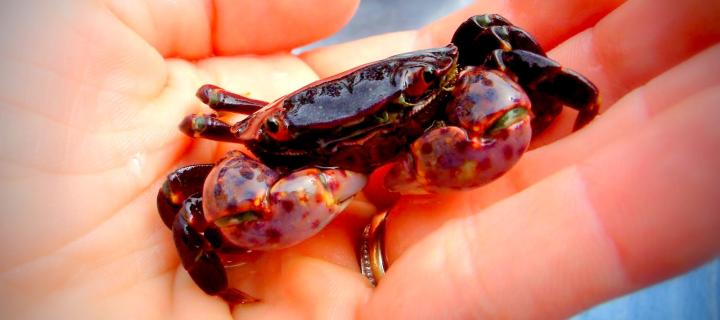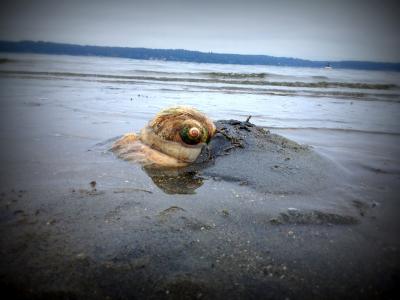
begin quote from:
SOUTH PUGET SOUND BEACH EXPERIENCES LET YOU GET SQUIRTED, SLIMED, STUCK AND SURPRISED
Monday, June 5, 2017 1:00 PM by Travel Tacoma

The following is a guest post by Jennifer Beard, the development associate for Harbor WildWatch, which is a 501(c)(3) non-profit environmental education organization based in Gig Harbor, Wash.
A negative tide in the South Puget Sound during the summer is a big positive. A low tide gives visitors a window into the Puget Sound and the special creatures which live in the intertidal zone without getting (too) wet. Not sure which beach to visit? Check out the Washington State Parks website or Pierce County Parks for some ideas. Here are some ideas to GET you exploring during your next trip.
Get Squirted – When the tide is way out you will notice (or get surprised by) squirting water. Some beaches have so much squirting, it looks like a children’s spray park. Many people think that the squirts come from geoducks (pronounced gooey-ducks), but most geoducks live below the tidal zone and are probably under water, unless it is an extremely low tide. More commonly, the squirts originate from the Rough Piddock clam. This clam rasps away at clay and soft rock to create a burrow where it will live for about 8 years. The part of the clam that beachgoers see is the siphon, which extends from the buried clam up to the water. The siphon allows water to circulate in and out of the clam for feeding, breathing and reproduction. Harbor WildWatch naturalists partner with the clams to play a little joke on the kids. The Rough Piddock clam, they say, smells like a rose and when the kids sniff the protruding clam siphon, they get a squirt on the nose. Kids, you can play this joke on your adults!
 Get Slimed – New visitors to the Puget Sound are often intrigued by the empty clam shells lying on the beach with a perfect hole drilled at the hinge. In fact, it looks manmade. But, the hole is drilled by the largest intertidal snail in the Puget Sound, the Lewis’s Moon Snail. The moon snail uses a special drilling appendage called a radula to make the hole and suck out the clam. The moon snail’s egg case is even stranger than the holes it drills. The egg case is a gray, rubbery ring that looks like a tossed -out car part. The moon snail mixes sand with a special slime and the eggs to make the case. By the end of summer the eggs hatch and the rings dissolve back into sand. These large snails can be found in the intertidal zone, but they are often buried in the sand looking for clams to eat. The only way you know they are there is a long crack in the sand. If you do pick up a moon snail, you may get lots of snail slime on your hands and you may even get squirted (again) when it expels all the water from its body so it can hide in its shell.
Get Slimed – New visitors to the Puget Sound are often intrigued by the empty clam shells lying on the beach with a perfect hole drilled at the hinge. In fact, it looks manmade. But, the hole is drilled by the largest intertidal snail in the Puget Sound, the Lewis’s Moon Snail. The moon snail uses a special drilling appendage called a radula to make the hole and suck out the clam. The moon snail’s egg case is even stranger than the holes it drills. The egg case is a gray, rubbery ring that looks like a tossed -out car part. The moon snail mixes sand with a special slime and the eggs to make the case. By the end of summer the eggs hatch and the rings dissolve back into sand. These large snails can be found in the intertidal zone, but they are often buried in the sand looking for clams to eat. The only way you know they are there is a long crack in the sand. If you do pick up a moon snail, you may get lots of snail slime on your hands and you may even get squirted (again) when it expels all the water from its body so it can hide in its shell.
Get Stuck – Not you, of course, but a sea star. The Mottled and Ochre sea stars are common inhabitants in the intertidal zone. Low tide to a sea star is like a B-grade horror movie because it is unable to move; stuck until the tide returns. This strange animal relies on a well-developed hydraulic system to move its tube feet. The sea star sucks water in through a special opening on the top of the central disc and moves through water through a “ring and ray canal” system to each leg and then out through the tube feet (and there are hundreds of tube feet!). Even stranger, the sea star has no heart, no eyes and no blood but it occupies the top predator position in its habitat. If you handle a sea star, please put it back in the shade of a rock or in the water so the sea star is not exposed to the hot sun.
Get Surprised – Children (and their adults) cannot help looking under the rocks on the beach. Each time you roll back a rock, you will be surprised by something new. First, pick a rock no larger than your head. This protects the animals living on and below the rock. If the rock is much larger, it can flop back into place, rather than being carefully lower, and animals can be squashed. Under most rocks you will see numerous shore crabs scuttling about. If you are lucky, you might see a chiton, flatworm or even a Midshipman fish. Please, put the rock and animals back gently. Place the rock in its original position because animals, like the barnacles, can die if flipped in a different way.
Get Involved – Did you have a fabulous time at the beach and want to learn more? Visit Harbor WildWatch.org and check out our online calendar. We have guided beach walks and touch tanks in Pierce and Kitsap County throughout the summer. Our staff and volunteers love to share the natural history of the Puget Sound with visitors. If you can’t make it to the beach, visit the Skansie Visitor & Interpretive Center in picturesque downtown Gig Harbor. Summer hours (June – September) are Wednesday - Sunday (10 am to 4 pm). The exhibits are free and fun for the whole family and include a touch tank, augmented reality sandbox and microscope activities.
You can take it to the next level with a Steward Club membership or become a Harbor WildWatch volunteer or citizen scientist.No prior experience necessary.We provide all the training.Our top priority is for you to embrace our motto: Learn. Have fun.
See you on the beach!
Harbor WildWatch's mission is to inspire stewardship for Puget Sound by providing learning opportunities about the environment to the people in the local community. Through more than 600 fun and interactive programs each year, Harbor WildWatch hopes to inform residents and visitors about local marine life and elicit their involvement in preserving our natural resources.
No comments:
Post a Comment